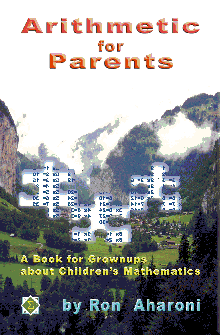Arithmetic for ParentsA Book for Grownups about Children's Mathematicsby Ron Aharoni |

|
The book under review is an outcome of a rare experiment: an university math professor (a high caliber professor at that from one of the best universities in the world) who has responded to a challenge to teach in elementary school shares the acquired insights about teaching young children and their mathematics. The book is a very enjoyable read, the advice proffered is sound, the pedagogy is illustrated by numerous examples. I highly recommend the book to the grown ups concerned with young children education. (The subtitle A Book for Grownups about Children's Mathematics reflects better than the title Arithmetic for Parents on the intended audience.)
The book includes Foreward, Introduction, three Parts (Elements, Principles of Teaching, Aritmetic from First to Sixth Grades) and an Appendix. In the Foreward, the author explains the structure of the book:
The first part of the book, Elements, describes the fundamentals of elementary mathematics. That is, it deals with the questions of what mathematics is, what the material is that should be taught in elementary school, and also what makes mathematics beautiful and similar to the arts.
... the second part of this book ... includes the principal rules of progressing from the concrete to the abstract. In addition, parents must also be familiar with the educational trends that determine the educational character of their child’s school. For this reason, the book includes an appendix describing, in a nutshell, the major developments in mathematical education over the last fifty years.
The third part of the book is devoted to the nitty-gritty of elementary mathematics, the details of the material taught in school, stage by stage. Although geometry constitutes between 10% and 20% of the usual curriculum, I decided to renounce it, and stick to arithmetic that is, the study of the properties of numbers.
In the Introduction, the author outlines the sequence of events that led him to taking up teaching elementary grades in a small town on the Northern outskirts of Israel and describes the surprise experiences that came out of that experiment. The greatest surprise was in that the teaching of elementary grades provided him - a professional mathematician - an opportunity to learn mathematics: not any new facts of course but the subtleties inherent in the elementary mathematics. (As an aside, this part supplies a crashing argument in the hotly discussed topic as to whether or not elementary school teachers can be expected to possess math expertise.)
The first part is a collection of interrelated essays that discuss the fundamental role of abstraction in mathematics, the mathematical beauty, the peculiar economy of thought and expression that characterizes mathematics and the its hierarchical organization. There are also chapters on the whole numbers, the decimals and general thoughts of what might be expected to be learnt in elementary school. Mathematical economy is beautifully classified as being achieved in three ways: Order (by looking for patterns), Generalization (by abstracting common features from different areas) and Concise Representation (the decimal system serving as an example.)
The second part is deftly subtitled The Road to Abstraction as conveying an abstraction is a fundamental need and principle of teaching mathematics. The author's methodology is to start with familiar and diversify the examples to help students grasp the abstraction as a common feature of several examples and prevent them from attaching unintended importance to auxiliary details. He has harsh words for a textbook where all examples of "real world" fractions referred to pieces of pizza. Students taught from that textbook had difficulty dividing a square into equal parts. Further on, he emphasizes the role of the teacher as a mediator and importance of naming math objects: operations and their parts (e.g., a quotient). He also argues against using calculators in elementary grades.
The third part is the largest - it takes about two thirds of the book. The third part opens with a chapter on the meaning of arithmetic operations. For example, there is a real (for children) difference between questions such as,
- There are five apples of which 2 have been eaten. How many apples have been left?
- In a family of 5 siblings, 2 are boys. How many girls are in the family?
- Joseph has 5 toys, Reena has 2. How many more toys does Joseph have?
All are naturally solved by subtraction
With the same attention to detail and profound insights, he then talks of the nature and rules of calculations, of fractions, decimals, and ratios. It is plain fascinating how much meaningful information is hidden behind simple arithmetic facts. There is so much that children may miss! There is so much to be learned in order to acquire a working grasp of the concepts of the elementary mathematics.
The book will be helpful to and enjoyed by teachers, parents who attend to their kids' study and, of course, the home schooling parents. It's a treasure trove of ideas usually missed out in textbooks and teacher manuals.
Arithmetic for Parents. A Book for Grownups about Children's Mathematics, by Ron Aharoni. Sumizdat, 2007. Softcover, 196 pp, $29.95 (Also available from sumizdat.org). ISBN 0-9779852-5-3.
|Up| |Contact| |Front page| |Contents|
Copyright © 1996-2018 Alexander Bogomolny73496889
